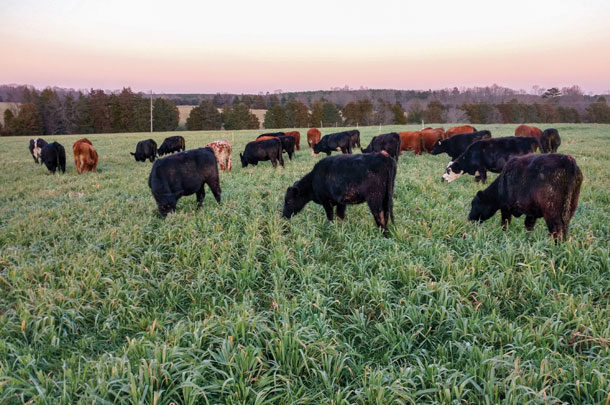Most forage systems are based on a dominant species, or “base forage,” but the base always has limitations in terms of yield and nutritive value during certain times in the year, so added diversity will bring benefits to most systems.
Annuals are an expensive option
As you study enterprise budgets, you may ask yourself why anyone would want to plant annuals. Because of seed, labor, equipment and fertilizer, forage from annuals may cost twice as much as for perennials. Many farmers do use annuals, so there must be other reasons beyond just the cost of the dry matter produced.
Depending on your animal production system, you may or may not have problems with the limitations of your base forage. For cow-calf production, calves can be weaned and sold when forage quantity or nutritive value become limiting, leaving the cows with plenty of forage resources to get through the year. However, for producers who are finishing cattle on grass or running stockers, it is critical to keep animal performance high, which means having good quality forage to switch to when the base perennial falls short of what is needed to maintain animal performance.
I work with systems which are primarily tall fescue-based or bermudagrass-based. Fescue has the limitation that so much of its yield comes in spring, and the nutritive value quickly declines as it matures (not to mention the impact of fescue toxicosis). With bermudagrass, most of its yield comes in mid-summer, and even at its best it only supports a moderate level of performance.
You could use a concentrate feed supplement to make up for the forage system limitations, but those feed inputs might actually be more expensive than using a strategically placed annual. Adding annuals to strategically span limitations in forage availability or nutritive value is the first reason you might want to add an annual to your system.
Take advantage of rapid advancements in forage genetics
Annual forage crops are continuously being improved, so planting some annuals means you have access to the latest genetic material every year. It is exciting, for example, to see all the genetic traits bred into sorghum-sudangrass forages including the Brown Midrib Trait (BMR), stature (brachytic dwarf), photoperiod sensitivity and others. Planting some annuals can keep you exploring new traits and forages, and finding alternatives which really seem to work with your system. Watching new varieties of annuals grow is exciting and can help maintain producer interest in their system.
Annuals may impact soil health
This concept has been discussed a lot, and in many situations using annuals as part of a renovation program can help improve soil in the long run. Annuals have very rapidly growing and strong root systems, allowing root penetration well below what most cool-season perennials do. Once these roots die, they leave a root channel deep in the soil which can be followed by future roots. Despite these general concepts, it is critical to understand soil health will likely be optimized with a long-term perennial planting, not with continuous growing of annuals, so annuals will have the best benefit to soil health when they are used along the way to a productive perennial-pasture.
Annuals aid in pasture renovation
Annual crops make a good renovation tool for perennial pastures. Killing the old stand of perennial, and then planting annuals, can give you immediately-improved animal performance and forage yield which had been lost in the old perennial stand. Planting annuals for a year or two will allow you opportunities to address weed and fertility problems which sometimes exist in these old perennial stands. Often old pastures have been heavily loaded with nutrients. In these situations you can achieve very high yields with a low level of fertilizer input, improving the economic benefit of the annual compared to what is in enterprise budgets.
Overseeding warm-season perennials
One of the most obvious places you should consider using annuals is if you have a warm-season base. For example, bermudagrass will only grow actively for about five to six months, resulting in a very long hay-feeding period if bermudagrass is the only forage. Producers with bermudagrass usually consider overseeding winter annual grasses such as ryegrass, oats, rye, wheat or combinations. We have also done work with winter annual legumes for overseeding on bermudagrass, and Austrian winter pea, hairy vetch, crimson clover and arrowleaf clover all give good yields and nutritive value, and each fixes about 100 pounds of nitrogen without adding fertilizer.
Annuals for grazing in rotation with row crops
One of the most popular topics of conversation throughout the industry is the potential to integrate grazing livestock with row crop production in order to use both crop residues (e.g. cornstalks) and to graze “cover crops.” There are many options to follow summer row crops with winter annuals, and grazing those crops in winter and spring allows for the opportunity to reduce total biomass residue, which can hamper seedling emergence in the following crop. It also gives the opportunity to turn some of the biomass into manure, which can be beneficial to nutrient cycling.
We will see a lot of development in this approach in the next decade, and if you are a livestock person with neighbors who are in the row-crop business, you might have an ideal opportunity to try this. A row-crop farmer might understand the benefits of grazing cover crops, but they often don’t want to have cows in the way year-round. The current technology we have with temporary electric fencing can make grazing on these row-crop farms a real option for many farmers.
Annuals help you be a better farmer
This is a key reason I recommend producers use some annuals in their system. Many of our producers don’t have much experience planting forage crops, especially if they are part-time and have a well-established perennial base. Incorporating annuals in your system requires you learn to do things timely, understand how to calibrate your drill, get the seed to the right depth and effectively operate the tractor and drill (avoiding skips and other problems which happen at this final step). There is more short-term risk in planting annuals; you take the associated risks every time you plant. However, if you mess up you have the opportunity to try again in the coming season. When planting perennials you only have to plant once, but how you get it done is really critical as you will have to live with it for the life of the stand.
Summary
Annuals have a role in very many forage systems even though on paper they appear to be a very expensive option. Plugging holes in an existing forage system, having opportunity to use cutting-edge genetics, improving success in pasture renovation projects, overseeding summer perennials, grazing annual cover crops and developing and maintaining your forage planting skills are all reasons you might consider annuals for your system. Why do you grow annuals? ![]()
PHOTO: Replacement heifers graze oats and ryegrass following breeding. Photo by Matt Poore.

-
Matt Poore
- Livestock Commodity Coordinator and Ruminant Nutrition Specialist
- North Carolina State University Extension
- Email Matt Poore










